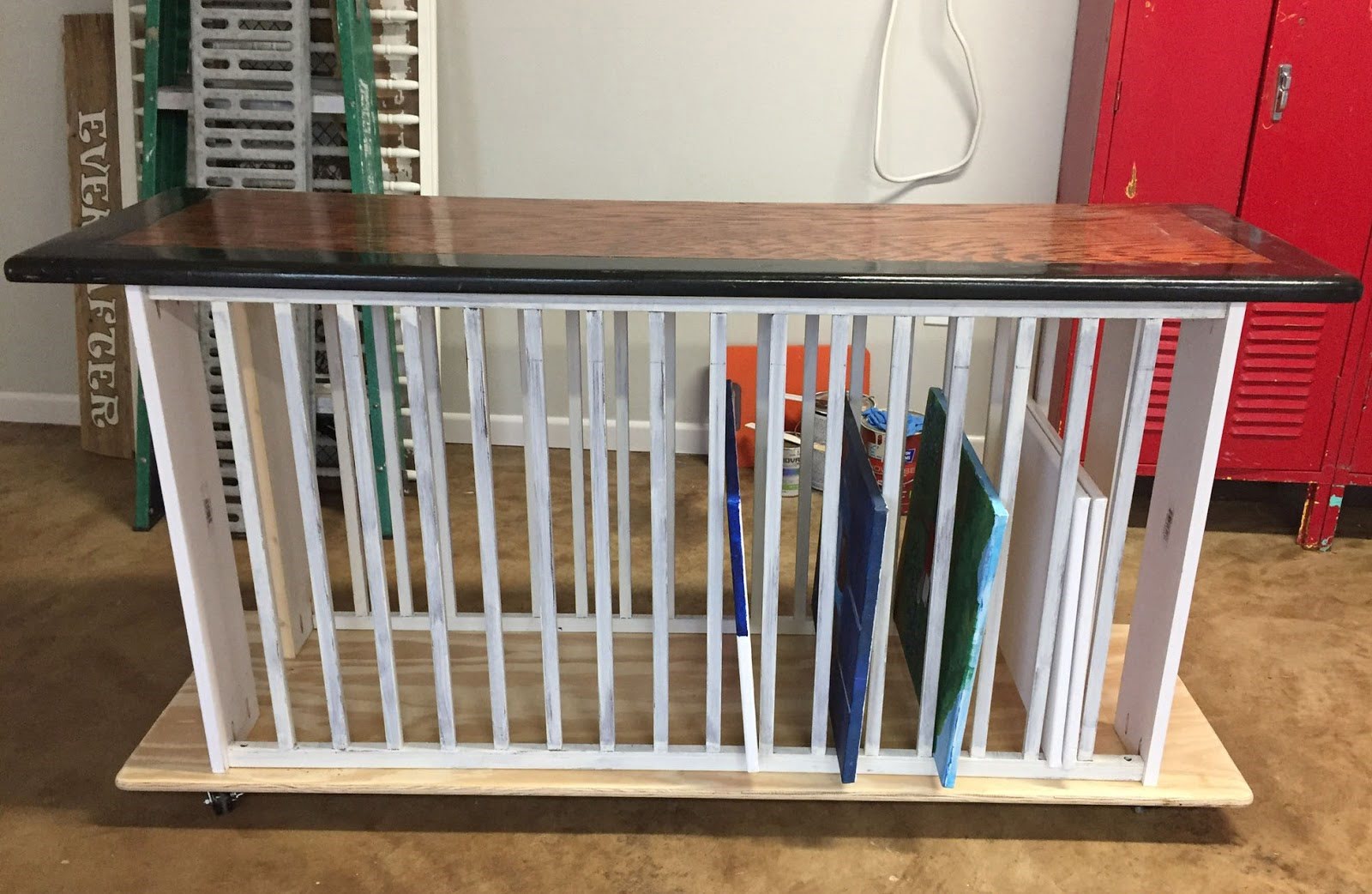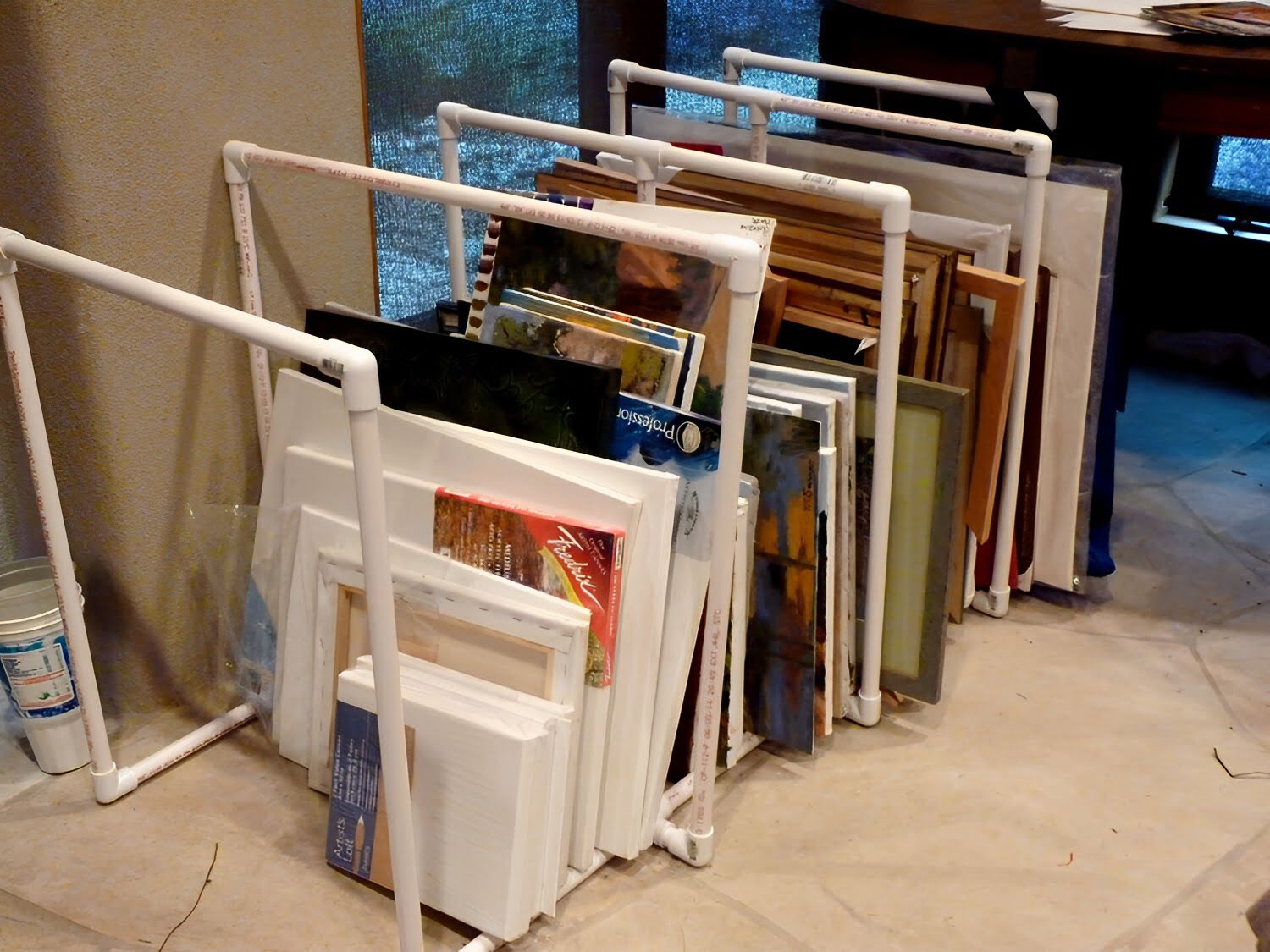

Articles
How To Store Canvas Art
Modified: December 7, 2023
Learn effective techniques for storing canvas art and preserving its quality. Discover expert tips and tricks to keep your articles safe and protected for years to come.
(Many of the links in this article redirect to a specific reviewed product. Your purchase of these products through affiliate links helps to generate commission for Storables.com, at no extra cost. Learn more)
Introduction
Canvas art has long been a popular and timeless form of expression. Whether it’s a priceless painting or a cherished family portrait, proper storage is essential to preserve its beauty and longevity. Storing canvas art correctly can protect it from damage caused by environmental factors, such as humidity and temperature fluctuations.
In this article, we will explore the importance of proper storage for canvas art and provide practical tips on how to store canvas art effectively. From choosing the right storage space to packaging techniques, we will cover all the essential steps to ensure your artwork remains in pristine condition.
By following these guidelines, you can rest assured knowing that your cherished canvas art will be well-preserved, allowing future generations to appreciate its beauty.
Key Takeaways:
- Preserve the beauty and value of canvas art by choosing the right storage space, preparing the artwork properly, and utilizing climate-controlled containers to protect against light, temperature, and physical damage.
- Regular inspection, maintenance, and professional consultation are essential for ensuring the longevity and optimal condition of canvas art, safeguarding its beauty and artistic significance for future generations.
Read more: How To Store Canvas Paintings
Importance of Proper Storage for Canvas Art
Proper storage is crucial for preserving the integrity and longevity of canvas art. Without appropriate measures, this delicate and sensitive medium can be susceptible to various forms of damage, including fading, yellowing, mold growth, and physical harm.
One of the primary concerns for canvas art is exposure to light. Ultraviolet (UV) rays can cause colors to fade over time, resulting in a loss of vibrancy and detail. By storing canvas art in a dark or low-light environment, you can minimize the risk of color degradation.
Humidity is another enemy of canvas art. High levels of moisture in the air can lead to mold growth, warping, and deterioration of the canvas itself. Conversely, extremely low humidity can cause the canvas to become brittle and prone to cracking. Maintaining a stable humidity level is essential to prevent these issues.
Temperature fluctuations can also adversely affect canvas art. Extreme heat or cold can cause the canvas to expand or contract, potentially leading to cracking or warping. It is important to store canvas art in a climate-controlled environment to prevent these temperature-related damages.
Additionally, proper storage helps protect canvas art from physical harm. Accidental bumps, scratches, or tears can occur when art pieces are not stored securely. By using appropriate packaging and storage techniques, you can safeguard your canvas art from such incidents.
Preserving the value and beauty of canvas art is not only important for aesthetic reasons but also for its potential financial worth. Many canvas art pieces appreciate in value over time, making proper storage even more critical for protecting your investment.
By giving careful thought to the storage of your canvas art, you can ensure that it remains in excellent condition for years to come, allowing you and future generations to appreciate its artistic splendor.
Choosing the Right Storage Space
When it comes to storing canvas art, selecting the right storage space is crucial. Here are some factors to consider:
1. Climate Control: Look for a storage space that offers climate control. This means the temperature and humidity levels can be regulated, providing a stable environment for your canvas art. Ideally, the temperature should be set between 68-72°F (20-22°C), and the relative humidity should be maintained between 40-50%.
2. Avoid Direct Sunlight: Choose a storage space that is shielded from direct sunlight. Exposure to UV rays can cause colors to fade and degrade the quality of the canvas. If natural light is present, consider installing UV-filtering blinds or curtains to protect your artwork.
3. Security Measures: Ensure that the storage space has robust security measures in place. Look for facilities with surveillance cameras, access controls, and alarm systems to protect your valuable canvas art from theft or unauthorized access.
4. Size and Capacity: Consider the size and capacity of the storage space. Ensure that it is large enough to accommodate your canvas art collection comfortably. Avoid overcrowding the space, as this may lead to accidental damage during retrieval or storage.
5. Accessibility: Evaluate the accessibility of the storage space. Choose a location that allows easy access to your artwork whenever you need it. This could be important if you plan to rotate your art collection regularly or if you require artwork for exhibitions or events.
6. Consider Environmental Factors: Take into account any environmental factors that may affect the storage space. For example, if you live in an area prone to natural disasters such as floods or earthquakes, it is wise to choose a storage facility located in a safer zone.
7. Insurance: Check if the storage space offers insurance coverage for your artwork. This will provide peace of mind in case of any unforeseen circumstances or accidents that may damage your canvas art.
Remember, choosing the right storage space is essential for ensuring the preservation and safety of your canvas art collection. Take the time to research and visit potential storage facilities to make an informed decision that aligns with your specific needs and requirements.
Preparing the Artwork for Storage
Before storing your canvas art, it is important to properly prepare it to minimize the risk of damage. Here are some essential steps to follow:
1. Clean the Artwork: Start by cleaning the surface of the canvas art using a soft, lint-free cloth or a feather duster. Remove any dust, dirt, or debris that may have accumulated over time. Avoid using water or cleaning solutions unless absolutely necessary and recommended by a professional conservator.
2. Fix Loose or Damaged Parts: Inspect the canvas for any loose or damaged parts, such as flaking paint or loose threads. If you notice any issues, it is best to have the artwork professionally restored before storing it to prevent further damage.
3. Remove Hanging Hardware: Take off any hanging hardware, such as nails, screws, or wire, from the canvas art. These protruding elements can cause scratches or punctures if left on during storage.
4. Document the Artwork: It is recommended to document your artwork before storage. Take detailed photographs or make a written inventory of each piece. Note any existing damage or unique characteristics. This documentation can be useful for insurance purposes or if you plan to loan or sell your artwork in the future.
5. Protective Barrier: Consider placing an acid-free, archival-quality barrier between the canvas and any wrapping materials. Acid-free glassine paper can be used to create a protective layer that prevents direct contact between the artwork and wrapping materials.
6. Avoid Plastic: Avoid using plastic or vinyl materials for wrapping or covering canvas art, as they can trap moisture and lead to mold growth. Opt for breathable materials instead.
7. Use Acid-Free Materials: When packaging your canvas art, use acid-free or pH-neutral archival materials. Acidic materials can cause discoloration and deterioration over time. Acid-free tissue paper and acid-free cardboard or foam boards can be used for added protection.
8. Consider Framing: If your canvas art is not already framed, consider framing it before storage. A well-fitted frame can provide an extra layer of protection against dust, moisture, and physical damage.
9. Label and Document: Label each wrapped artwork with its title, artist, and any other relevant information. This will make it easier to identify the piece when retrieving it from storage and will prevent accidental mishandling or confusion.
By following these steps, you can ensure that your canvas art is adequately prepared and protected before it is stored. Taking the time to properly prepare your artwork will help preserve its quality and increase its longevity.
Wrapping and Packaging Techniques
Proper wrapping and packaging are vital for protecting canvas art during storage. Follow these techniques to ensure your artwork remains safe and in pristine condition:
1. Start with Acid-Free Tissue Paper: Begin by wrapping the canvas art in acid-free tissue paper. This lightweight, archival-quality paper provides an additional layer of protection against dust and scratches. Gently fold the tissue paper around the artwork, avoiding any excessive creasing or pressure.
2. Use Bubble Wrap: After wrapping the artwork in acid-free tissue paper, place a layer of bubble wrap over it. Bubble wrap provides cushioning and helps absorb shock during handling and transportation. Make sure the bubble side is facing outward to create a protective barrier.
3. Secure with Tape: Use painter’s tape or low adhesive tape to secure the bubble wrap in place. Avoid using regular tape or duct tape as they can leave residue and potentially damage the surface of the canvas if removed improperly.
4. Pack in a Sturdy Cardboard Box or Crate: Place the wrapped artwork inside a sturdy cardboard box or wooden crate. Ensure the box or crate is of appropriate size, allowing enough space for padding and avoiding any excessive movement during storage. Consider using acid-free foam or cardboard inserts to provide additional support and prevent shifting.
5. Label the Packaging: Clearly label the outside of the packaging with the artwork’s title, artist, and any specific handling instructions, such as “Fragile” or “This Side Up.” This will help prevent mishandling and ensure proper care during storage and retrieval.
6. Consider Climate-Controlled Storage Containers: If you have multiple pieces of canvas art or valuable artwork, you may opt for climate-controlled storage containers. These containers offer an added layer of protection by maintaining stable temperature and humidity levels.
7. Stack Artworks Properly: When storing multiple artwork pieces, stack them vertically rather than horizontally. This reduces the pressure applied to the canvases and minimizes the risk of damage. Place foam or cardboard sheets between each piece for added protection.
8. Avoid Overpacking: While it’s important to provide ample protection, avoid overpacking the storage container as excessive compression can damage the artwork. Find a balance between sufficient padding and allowing some breathing space for the canvas.
Remember, each artwork may have unique requirements, so it’s crucial to research specific packaging and handling instructions if provided by the artist or art conservator. Proper wrapping and packaging techniques will help safeguard your canvas art during storage and transportation, ensuring it remains in excellent condition for years to come.
When storing canvas art, make sure to keep it away from direct sunlight, extreme temperatures, and high humidity. Store it vertically in a cool, dry place to prevent warping or damage.
Read more: How To Store Canvas Prints
Storing Canvas Art in Containers
When it comes to storing canvas art, using containers can provide an extra layer of protection. Follow these guidelines to ensure your artwork remains safe and well-preserved:
1. Choose the Right Container: Select a container that is specifically designed for artwork storage. Look for containers made from acid-free materials, such as archival boxes or acid-free plastic bins. These containers help prevent acid transfer and minimize the risk of damage to the artwork.
2. Consider Size and Fit: Ensure that the container is spacious enough to accommodate your canvas art comfortably. Avoid choosing a container that is too small, as this may lead to bending or folding of the canvas. However, also avoid using oversized containers that allow excessive movement of the artwork.
3. Add Padding: Place a layer of acid-free foam or cardboard at the bottom of the container to provide cushioning and protect the artwork from any impact during storage. You can also add additional padding between multiple pieces of canvas to prevent them from coming into contact.
4. Position the Artwork: Place the wrapped and packaged artwork inside the container, placing it in an upright standing position if possible. If vertical storage is not feasible, lay the artworks flat, but avoid stacking too many on top of each other to prevent undue pressure.
5. Separate with Divider: If storing multiple artworks in one container, consider placing acid-free foam or cardboard dividers between each piece. This will prevent any direct contact and potential damage caused by rubbing or shifting during storage.
6. Label the Container: Clearly label the exterior of the container with the artwork’s details, including the title, artist, and any special handling instructions. Use waterproof and fade-resistant labels to ensure the information remains visible and intact over time.
7. Store in a Clean, Dry Location: Find a suitable storage area that is clean, dry, and free from extreme temperature and humidity fluctuations. Avoid storing the container in basements, attics, or areas prone to leaks or pests. Ideal storage locations include dry closets, spare rooms, or climate-controlled storage facilities.
8. Avoid Stack Overflow: Avoid stacking heavy or bulky items on top of the container to prevent any potential damage to the artwork within. Ensure that the container is placed in a stable and secure position, reducing the risk of accidental tipping or falling.
9. Regular Inspection: Periodically check on the stored artwork to ensure there are no signs of damage or environmental issues. If necessary, adjust the surroundings or address any concerns promptly to maintain the artwork’s optimal condition.
By storing your canvas art in suitable containers, you can protect it from dust, light, and physical damage. Taking these precautions will help mitigate risks and ensure that your artwork remains well-preserved and ready to be enjoyed for years to come.
Hanging and Displaying Stored Canvas Art
Once you have stored your canvas art, it’s important to ensure that it is hung and displayed properly when the time comes to showcase it. Here are some tips for hanging and displaying stored canvas art:
1. Inspect the Artwork: Before hanging the artwork, carefully inspect it for any signs of damage or deterioration. Check for loose threads, flaking paint, or any other issues that may have occurred during storage. If you notice any problems, consider having the artwork professionally restored before displaying it.
2. Select the Right Location: Choose a suitable location for displaying your canvas art. Avoid areas that receive direct sunlight, as prolonged exposure to UV rays can cause the colors to fade over time. Also, keep the artwork away from sources of heat or moisture, such as radiators or humidifiers.
3. Hanging Hardware: Use appropriate hanging hardware to securely mount the artwork on the wall. Use sturdy hooks or screws that can support the weight of the canvas. The hardware should be properly aligned with the back of the canvas, ensuring that it is level when hung.
4. Consider Framing: If your canvas art is not already framed, consider framing it before hanging. A well-chosen frame not only adds aesthetic appeal but also provides additional protection for the artwork. Make sure to use acid-free materials and UV-resistant glass to prevent damage from harmful elements.
5. Proper Hanging Height: Determine the ideal height at which to hang your canvas art. The center of the artwork should be at eye level or slightly above, allowing viewers to comfortably observe and appreciate the details. Consider the overall aesthetics of the room and the surrounding décor when determining the placement.
6. Arrange Groupings: If you have multiple canvas art pieces to display, consider arranging them in pleasing groupings. Create a balanced composition by spacing the artworks evenly and considering the relationships between colors, themes, or styles. Experiment with different arrangements to find the most visually appealing display.
7. Use Spotlights: Consider using spotlights or track lighting to highlight your canvas art. Proper lighting can enhance the colors and details, creating a more captivating display. Avoid using harsh or direct lighting that may cause glare or shadows. Opt for adjustable fixtures that allow you to control the angle and intensity of the light.
8. Rotation and Refreshment: Periodically rotate your displayed canvas art to prevent prolonged exposure to light and ensure equal enjoyment of your collection. This also gives you an opportunity to refresh the display and appreciate different pieces at different times.
9. Regular Cleaning: Dust the artwork regularly using a soft, dry cloth or a feather duster to remove any buildup. Avoid using water or cleaning solutions unless recommended by a professional conservator. Check the condition of the artwork during cleaning, and address any emerging issues promptly.
By following these tips, you can ensure that your stored canvas art is properly hung and displayed, allowing you and others to enjoy its beauty and artistic brilliance. Create a visually appealing and safe display that showcases the unique qualities of each artwork.
Climate Control and Temperature Considerations
Climate control is essential for preserving the quality and longevity of your canvas art. Maintaining a stable temperature and humidity level can prevent damage caused by moisture, fluctuating temperatures, and mold growth. Here are some important considerations when it comes to climate control:
1. Temperature: The ideal temperature for storing canvas art is between 68-72°F (20-22°C). Avoid storing artwork in areas with extreme temperature fluctuations, such as attics or basements, as this can cause the canvas to expand or contract, leading to warping or cracking. Optimal temperature conditions help to maintain the stability of the canvas and prevent deterioration.
2. Humidity: Relative humidity (RH) levels should ideally be maintained between 40-50% to prevent mold growth and mitigate the risk of damage. High humidity can lead to moisture absorption by the canvas, resulting in mold growth and warping. Extremely low humidity can cause the canvas to become brittle and prone to cracking. Using a dehumidifier or humidifier can help regulate humidity levels, especially in areas where natural humidity is high or low.
3. Monitoring: Regularly monitor the temperature and humidity levels in the storage area using a hygrometer and thermometer. This will allow you to stay informed about any fluctuations and take necessary measures to adjust the climate conditions if needed. Some advanced climate control systems offer automated monitoring and alert systems to ensure consistent environmental conditions for your artwork.
4. Avoid Drastic Changes: Sudden and drastic changes in temperature and humidity can be detrimental to canvas art. Avoid exposing artwork to direct sunlight or placing it near heating or cooling vents. Limit exposure to drafts, as rapid changes in temperature and humidity can cause stress on the canvas, leading to damage over time.
5. Climate-Controlled Storage: If you live in an area with extreme climate conditions or struggle to maintain proper temperature and humidity levels in your home, consider using a climate-controlled storage facility. These facilities are designed to provide a controlled environment that safeguards your canvas art from temperature and humidity fluctuations.
6. Sealing and Insulation: Ensure that the storage area is properly sealed and insulated to minimize the impact of external climate variations. Use weatherstripping around windows and doors to prevent airflow and moisture infiltration.
7. Ventilation: Good air circulation is crucial to prevent the buildup of stagnant air and moisture. However, strike a balance between ventilation and dust control. Excessive airflow may introduce dust particles that could settle on the artwork. Use air filters or consider using display cases or framed storage to maintain a controlled environment while ensuring adequate airflow.
8. Professional Consultation: If you have valuable or delicate canvas art, it is advisable to consult with a professional art conservator. They can provide specific advice based on the materials and condition of your artwork, as well as recommend appropriate climate control methods to ensure its preservation.
By maintaining a climate-controlled environment and adhering to proper temperature and humidity levels, you can protect your canvas art from the harmful effects of moisture, mold, and temperature fluctuations. This will help preserve its integrity and ensure that it can be enjoyed for generations to come.
Regular Inspection and Maintenance
Regular inspection and maintenance are essential to ensure the ongoing preservation and condition of your canvas art. By conducting routine checks and addressing any issues promptly, you can prevent potential damage and prolong the longevity of your artwork. Here are some important tips for regular inspection and maintenance:
1. Visual Assessment: Conduct a visual assessment of your canvas art periodically. Look for any signs of damage, such as cracks, discoloration, flaking paint, or mold growth. Pay attention to the edges and corners of the canvas, as they are more susceptible to wear and tear.
2. Dust Removal: Dust your artwork regularly using a soft, dry microfiber cloth or a feather duster. Avoid using harsh cleaning agents or water, as this can potentially damage the canvas. Gently wipe the surface in a downward motion to remove any settled dust particles.
3. Spot Cleaning: If you notice any localized stains or marks on the canvas, consult a professional art conservator for guidance on spot cleaning techniques. They can provide advice on suitable cleaning solutions and methods based on the specific type of artwork and materials used.
4. Frame Inspection: If your canvas art is framed, inspect the frame for any signs of damage or loosening. Check for loose screws, chips in the frame, or discoloration of the glass. If you notice any issues, repair or replace the frame as necessary to ensure the artwork remains securely protected.
5. Environmental Conditions: Monitor the temperature and humidity levels in the storage area to ensure they are within the recommended range. Use a hygrometer and thermometer to regularly measure and record the climate conditions. Adjust the environmental controls if needed to maintain optimal conditions for your artwork.
6. Display Rotation: If you have multiple pieces of artwork on display, consider rotating them periodically. This helps to prevent overexposure to light and reduces the risk of damage caused by prolonged hanging. Take care when handling and rehanging the artwork to avoid accidental damage.
7. Professional Conservator: Consult a professional art conservator for regular, in-depth inspections and conservation assessments. They can assess the condition of your canvas art, identify any underlying issues, and recommend appropriate treatments or maintenance procedures to ensure its long-term preservation.
8. Documentation: Keep detailed records of your artwork, including purchase receipts, certificates of authenticity, and any conservation or restoration documentation. This information not only helps with provenance but also aids in future assessments, valuations, and insurance claims.
9. Insurance: Ensure that your artwork is adequately insured against damage, theft, or other unforeseen events. Review your insurance coverage regularly to confirm it provides appropriate protection for the value of your canvas art collection.
Regular inspection and maintenance are crucial for preserving the condition and integrity of your canvas art. By being proactive and addressing any issues promptly, you can ensure that your artwork remains in optimal condition and can be enjoyed for years to come.
Read more: How To Hang Canvas Wall Art
Conclusion
Proper storage and maintenance of canvas art are essential for preserving its beauty, protecting its value, and ensuring its longevity. By following the guidelines outlined in this article, you can create an environment that safeguards your artwork from damage caused by light exposure, fluctuating temperatures, humidity, and physical harm.
Choosing the right storage space, preparing the artwork for storage, and utilizing appropriate wrapping and packaging techniques are crucial steps in protecting your canvas art during storage. Storing the artwork in containers, hanging and displaying it correctly, and maintaining a climate-controlled environment are important considerations that help preserve its quality.
Regular inspection, maintenance, and cleaning play vital roles in identifying any issues early on and addressing them promptly. Taking the time to inspect your artwork and maintain optimal conditions will go a long way in prolonging its lifespan and ensuring it can be enjoyed for generations to come.
Remember to consult with professional art conservators when needed, especially for valuable or delicate artwork. Their expertise and guidance can help you make informed decisions and provide specialized care for your canvas art.
By implementing these best practices and investing in the proper storage and maintenance of your canvas art, you can safeguard its beauty, protect its value, and continue to appreciate its artistic significance for years to come.
Frequently Asked Questions about How To Store Canvas Art
Was this page helpful?
At Storables.com, we guarantee accurate and reliable information. Our content, validated by Expert Board Contributors, is crafted following stringent Editorial Policies. We're committed to providing you with well-researched, expert-backed insights for all your informational needs.














0 thoughts on “How To Store Canvas Art”